Speech and Variations in Sensations
Sensory abnormalities reduce an individual's ability to process sensory information from their surroundings. People with sensory deficits may get too aroused by information from their surroundings, such as sounds, touch, and sight. This is one component of the autism diagnosis.
Imagine walking into a classroom after emerging from a shadowy area. The lights are turned to maximum brightness, and your eyes fight to adjust. Even when a headache begins, the lights stay on. Meanwhile, your teacher speaks and provides students with instructions. It would take a lot of effort to concentrate.
This is one example of how sensory impairments can make regular tasks difficult. Some people with sensory processing disorders may struggle to process many sensory cues, such as the sound of the teacher's voice or the feel of their clothing against the skin. As a result, participating and paying attention may be challenging. For some neurodivergent people, this occurs frequently, and sensory dysregulation can significantly limit various activities.
- Hypersensitivity: Sensory differences can occur in children.
- Extremely sensitive. A tiny sensory input may make a child dysregulated and too focused. This can be demonstrated through fleeing, shouting, or hiding.
- Hyposensitivity: A youngster requires a large amount of sensory input to respond. Two ways to express this are sluggishness and disinterest.
Sense-Based Methods
Professionals, educators, parents, and other adults involved in a child's life can help children with sensory difficulties interact with their environment in various ways.
Make a note. You can accomplish this by saying something like, "I'm going to start vacuuming now," or by providing visual cues.
Identifying difficulties: If your child appears to have trouble adjusting to new sensory input, pinpoint the problem.
I am helping with self-awareness. Invite the young person to explain their preferences. For example, "I noticed you like it when the house is quiet." Please elaborate on that.
Problem Solving: Collaborating with young people to solve problems. Say something like, "To clean the house, I need to vacuum." How do we make sure that we all have what we need?
Learn more about speech delay disorder treatment Sydney.
.jpg)

.jpg)
Comments
Post a Comment